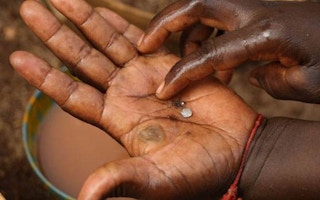At Umicore’s industrial facility in Antwerp, hundreds of workers wearing yellow safety vests turn up every day to recover gold, silver, copper, lithium and other metals and minerals from towering piles of discarded mobile phones.
The company is now one of the biggest players in a new industry that has the potential to transform the way we consume the raw materials used in the increasing numbers of electronic devices we buy each year.
Urban mining, as this activity is called, aims to recycle some of the estimated $62.5 billion-worth of electronic waste generated each year—about three times the value of the world’s annual silver production.
Computers, mobile phones and other electronic products use a staggering 320 tonnes of gold, and more than 7,500 tonnes of silver every year, according to the Global e-Sustainability Initiative (GeSI), a collaboration between technology companies and the United Nations University.
But beyond the business prospects, the rise of urban mining offers an example of how circular economies can replace linear ones to transform not only the way we consume but also the negative impact our consumption has on the planet.
For decades, industrialised countries have disposed of huge quantities of e-waste by exporting it to developing regions such as West Africa. Agbogbloshie in Ghana used to be an area of wildlife and natural beauty.
Today, it is the world’s largest dumpsite for used electronic goods from Europe and beyond. Impoverished families work in toxic and hazardous conditions to recycle e-waste materials manually, which is inefficient and often dangerous.
Urban mining heralds the prospect of recycling much more e-waste in consumer countries, cutting down on traditional transportation, which contributes to global warming. It can also recover greater quantities of metals and other materials from e-waste than the predominantly manual recycling process carried out in Africa, India and other developing regions.
“
For decades, industrialised countries have disposed of huge quantities of e-waste by exporting it to developing regions such as West Africa.
Most importantly, urban mining can help reduce the amount of traditional mining activity in the world, an increasing amount of which is carried out in environmentally sensitive areas and where mining companies are having to dig ever deeper to extract raw materials.
E-waste is a surprisingly rich alternative to traditional mining—just one tonne of e-waste contains more gold than 17 tonnes of ore—and is achieving rapid cost reductions through improvement of technologies, collection systems and growing economies of scale.
As many as 17 different metals can be extracted from e-waste, including silver, platinum, copper, tin and antimony. There is also plenty of it, with the United Nations University estimating that annual e-waste is set to more than double by 2050.
There are encouraging signs of progress towards a more defined circular economy for electronics. The European Union’s revised framework on waste targets a 65 per cent reduction in municipal waste by 2035, building on previous directives aimed at waste electronic equipment.
At the company level, initiatives are in full swing. Volkswagen is building a battery recycling plant that will support the carmaker’s goal of recycling 97 per cent of raw materials in end-of-life EV battery packs—up from 53 per cent today. Apple has a goal of making all of its products from recycled materials. The California technology company has even piloted robotic tools to help disassemble iPhones.
Even so, more needs to be done. Many countries lack any kind of legislation to deal with e-waste. And even with regulations covering the export of e-waste, the EU sees an estimated 1.3 million tonnes of e-waste exported illegally every year. Meanwhile consumers must become more aware of the need to recycle their e-waste in a responsible way.
A report this year by the World Economic Forum noted that a circular economy for electronics could reduce the costs to consumers by seven per cent by 2030, and 14 per cent by 2040.
With more effort, urban mining could therefore become a win-win: benefiting consumers and producers while simultaneously making sure that our planet does not become a landfill of hazardous waste.
Vincent Magnenat is the CEO of Lombard Odier Group in Asia Pacific.











